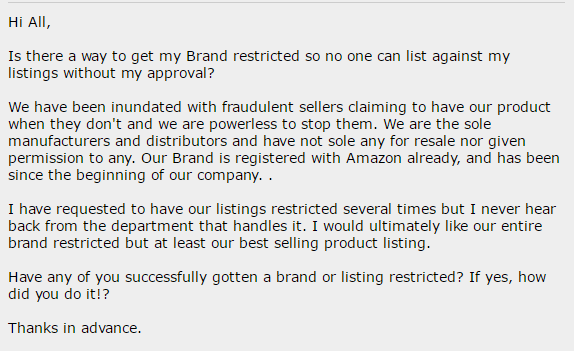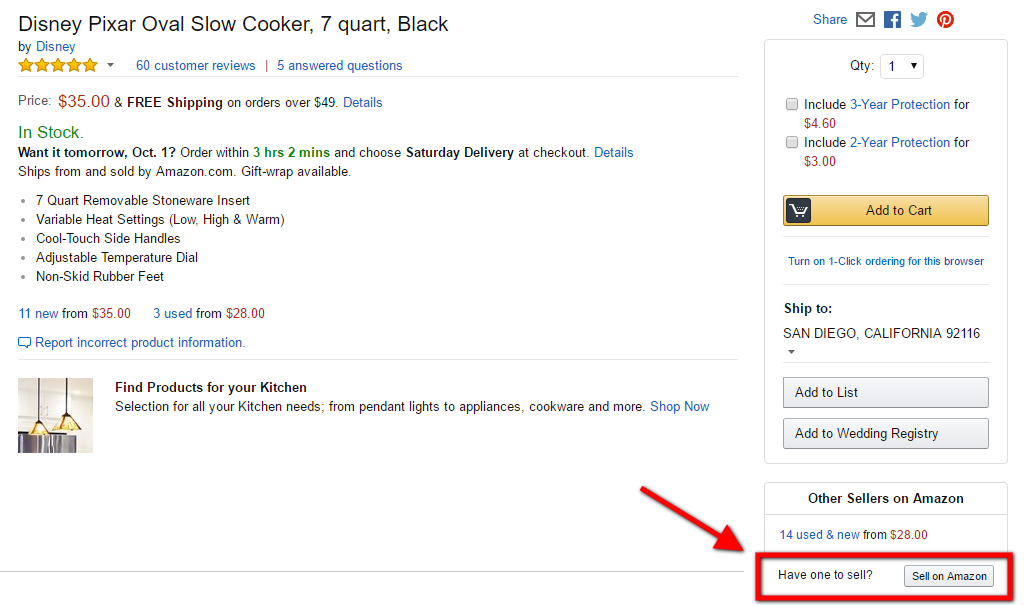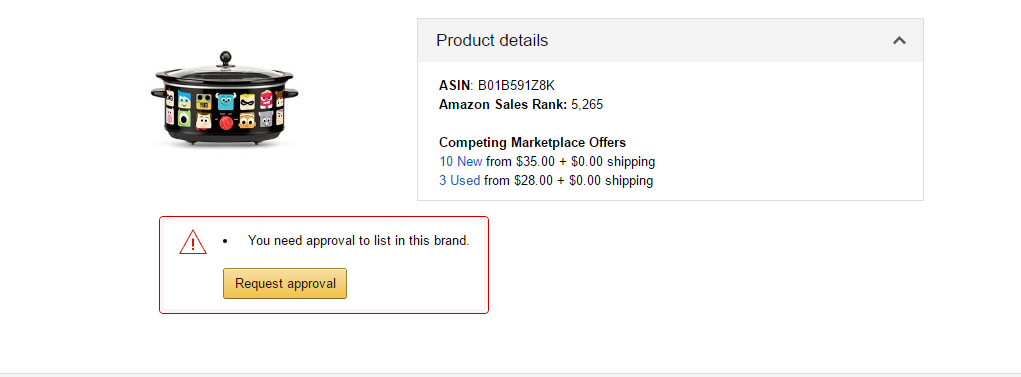How to Get Your Brand Gated on Amazon, According to a Lawyer

Recently, we shared a post covering the truth about Amazon’s new Brand Gating policy, and how it will affect sellers.
We got floods of questions from private labeler and brand manufacturers in response, all asking one thing: How can I get my products or brand gated/restricted on Amazon?
Brand Gating is just one piece of the brand policing “pie,” but with all of the recent brand policing issues running rampant on Amazon, it’s clear that Brand Gating may be the most effective way to start.
After all, Brand Gating permits a seller to set up a perimeter or wall around their ASINs or their entire brand and helps prevent illegitimate third-party sellers from jumping on listings (and potentially tanking ratings).
We sat down with Suzi Hixon, an Amazon Private Label Lawyer with experience getting brands gated on Amazon, to see how easy it is for a brand that’s not Nike to get gated.
We’ve talked about the counterfeit problems many brands are experiencing on Amazon, and the much-covered departure of Birkenstock due to that issue. Those “listing hijackers” can really wreak havoc on your brand, and we’ve seen clients affected by it.
Just check out this post by a seller on the Amazon Seller’s forum:

Could Brand Gating help stem these issues that some brands have to deal with on a daily basis?
According to Hixon, who has to walk many clients through the process of kicking hijackers off listings, the answer is a resounding yes.
 “We’re seeing so many counterfeit issues on Amazon, at times it can feel like you’re playing Whack-a-Mole,” agrees Hixon. “Brand Gating can be a way to pre-emptively deal with this problem.”
“We’re seeing so many counterfeit issues on Amazon, at times it can feel like you’re playing Whack-a-Mole,” agrees Hixon. “Brand Gating can be a way to pre-emptively deal with this problem.”
The thing is, Amazon started out by proactively gating heavyweights such as Nike, KitchenAid, and Dell.
Do smaller brands and private labelers even have a chance at being gated?
Yes again, says Hixon.
“Amazon is rolling this out for regular people like you and me, not just mega-brands. Anyone can request it, and it’s a really good deterrent,” says Hixon.
And if you have several private labels/brands, you can work on gating all of them.
“One of my clients has several brands, and we’ve been working on gating his brand for four weeks,” says Hixon. “We found out that one we didn’t request just got gated. They may be rolling this out to private labelers–but not sure what the metrics are.”
Amazon might proactively gate your brand without you requesting. But you don’t have to wait for that to happen while your brand gets raided by unauthorized resellers and counterfeit product sellers.
Here are the steps you can take to request your brand or listing restriction today.
Don’t waste your time trying out different methods of getting gated. Hixon has used this process to successfully get sellers gated since her first one—a small pet product brand.
“I’m a huge animal lover, and my first client was a brand that had a lot of pet products…you don’t have to be a mega-brand to be eligible for Brand Gating,” Hixon says.
Many sellers believe that Amazon’s Brand Registry on its own will help protect their brand on its own. Well, unfortunately, that’s not really the purpose of the program, but that doesn’t mean you shouldn’t do it. It’s a crucial step in the Brand Gating process.
“The brand registry program and Brand Gating are two different things,” says Hixon. “However, sellers have [register their brand on Amazon’s Brand Registry first]. Otherwise, Amazon won’t even consider them for Brand Gating.”
Learn more about the Amazon Brand Registry in our post:
https://tinuiti.com/blog/2015/10/amazon-brand-registry/
This is not mandatory, but Hixon strongly recommends that you get your brand trademarked under the United States Patent and Trademark Office.
Why do it? Because it shows Amazon that you take your brand seriously.
“I believe it helps in terms of getting a brand gated,” Hixon explains. “And I personally want to see that the client is proactively protecting their brand before I try to get it gated.”
If you want to learn more about the importance of trademarks and copyrights, check out our post:
https://tinuiti.com/blog/2015/08/amazon-trademark-copyright-infringement/
Every brand wants to be gated. But sometimes, individual ASINs get gated before an entire brand will–which is why sellers should send in the exact ASINs they want to prioritize for brand gating.
Wondering who you should submit these ASINs to? Hixon has a designated contact within Amazon that she works with. For sellers who are working on their own, Hixon recommends reaching out to current support contacts at Amazon with your list.
And if you have tons of ASINs, you don’t have to send them all.
“If you have thousands of ASINs or parent ASINs with a lot of child ASINS, provide Amazon the one you have the most counterfeit activity on or ones that are the most valuable,” Hixon explains.
No, you don’t have to have a lot of counterfeit issues to get gated. But Hixon has noticed that Amazon may give priority to sellers who are currently fending off counterfeiters. Hixon explains:
“Amazon’s all about protecting the customer, and when it comes to counterfeit items, Amazon’s not just about protecting the seller—it’s very much about the customer.”
It’s a simple step, but it’s important to remember all of the details in your first message. That way, you won’t delay Amazon in the Brand Gating process.
Now, we all know Amazon is a massive company with a lot of moving parts. Sometimes, those moving parts aren’t able to notify you every single time something changes on your account—nor should they have to. After all, they’re basically doing extra work to protect your brand!
According to Hixon, it can take 4-5 weeks for Amazon to set up brand protection.
Here’s how you can tell your ASINs have been gated:


If you successfully got your brand or some valuable ASINs gated, congratulations! If you were unsuccessful, here are a few potential reasons why:
If you don’t take that step to get your brand registered on the Amazon Brand Registry, Amazon will not even consider gating your brand, according to Hixon.
Hixon estimates that it takes at least 4-5 weeks for Amazon to get a brand or specific ASINs gated. The more necessary info you withhold, the more back-and-forth dialogue you create between you and Amazon, and you’ll extend the process.
This includes notifying Amazon about the authorized resellers on your listings.
At this point, you may be wondering if it’s worth getting a lawyer to take care of this for you. You don’t have to work with a lawyer to get your brand gated, but it could help, particularly if it’s your first time.
The real key is to know exactly what Amazon wants (all of the above), which speeds up the process and improves your chance of getting gated the first time.
“I’ve brand gated enough to know exactly what Amazon wants,” says Hixon. “I’m able to give them everything they need right off the bat to expedite the process. Sometimes, I think the fact that an attorney is [backing you up] helps—it shows the seller is investing in protecting their brand, and isn’t frivolous in what they’re doing.”
Brand Gating is actually a pretty fantastic development for brands, who are more likely to feel comfortable putting their brand on Amazon. (Who knows–perhaps Birkenstock will return.)
But Amazon has a track record of making changes, and Hixon has her own thoughts on how the Brand Gating process will change in the future.
“Requesting Brand Gating seems straightforward now, but I’m wondering if Amazons’ going to require the brand owner to pay for that at some point. At the end of the day, if you are gating your ASIN, you’re preventing other 3rd parties from listing against that ASIN, and listing products as new. That means fewer products for Amazon to sell, thus less money for Amazon to make.”
Bottom line? Sellers, if you want your brands or ASINs to be gated, there’s no time like the present.
